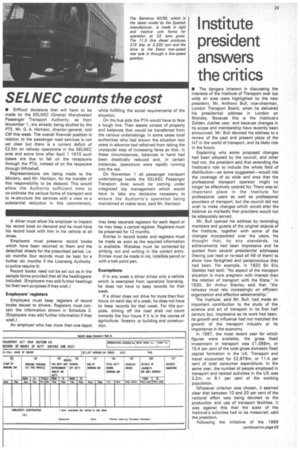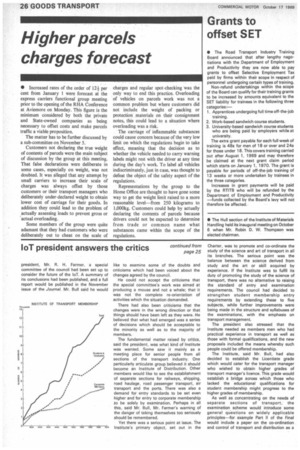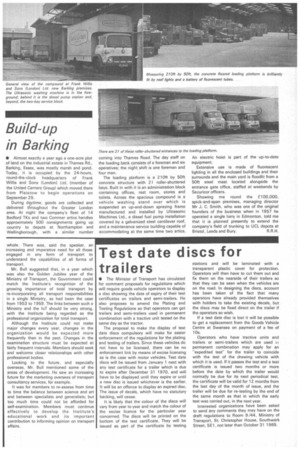Institute president answers the critics
Page 27

Page 28

Page 29

If you've noticed an error in this article please click here to report it so we can fix it.
• The dangers inherent in discussing the interests of the Institute of Transport over too wide an area were highlighted by the new president, Mr. Anthony Bull, vice-chairman, London Transport Board, when he delivered his presidential address in London on Monday. Because this is the institute's Golden Jubilee year, and because changes in its scope and membership have recently been announced, Mr. Bull devoted his address to a review of the past and present place of the loT in the world of transport, and its likely role M the future.
Explaining why some proposed changes had been adopted by the council, and other had not, the president said that extending the Institute's role to include the whole field of distribution—as some suggested—would risk the coverage of so wide and area that the professional transport operator might no longer be effectively catered for, There was an important place in the Institute for professional users as well as professional providers of transport, but the council did not wish to make changes which would alter the balance so markedly that providers would not be adequately served,
Mr. Bull opened his address by reminding members and guests of the original objects of the Institute, together with some of the changes incorporated over the years. He thought that, by any standards, its achievements had been impressive and he quoted from several presidentral addresses (having lust read or re-read all 48 of them) to show how farsighted and perspicacious they had been. For example, in 1920 Sir Eric Geddes had said: "No aspect of the transport situation is more pregnant with interest than the relation of transport with the State," In 1930, Sir Arthur Stanley said that -the railways must rely increasingly on efficient organization and effective salesmanship."
The Institute, said Mr. Bull, had made an important contribution to the study of the science and art of transport in its first half century but, impressive as its work had been, its growth and influence had not matched the growth of the transport industry or its importance in the economy.
In 1967, the most recent year for which figures were available, the gross fixed investment in transport was £1,099m, or 15.4 per cent of the total gross domestic fixed capital formation in the UK. Transport and travel accounted for £2,879m, or 11.4 per cent of total consumer expenditure. In the same year, the number of people employed in transport and related activities in the UK was 2.2m, or 9.1 per cent of the working population.
Whatever criterion was chosen, it seemed clear that between 10 and 20 per cent of the national effort was being devoted to the production and use of transport facilities. It was against this that the scale of the Institute's activities had to be measured, said the president.
Following the initiative of the 1966
president, Mr. Ft. H. Farmer, a special committee of the council had been set up to consider the future of the loT. A summary of its conclusions had been published, and a full report would be published in the November issue of the Journal. Mr. Bull said he would
like to examine some of the doubts and criticisms which had been voiced about the changes agreed by the council.
He could not accept the criticisms that the special committee's work was aimed at producing a mouse and not a whale; that it was not the complete re-orientation of activities which the situation demanded.
There had also been criticisms that the changes were in the wrong direction or that things should have been left as they were. He believed that what had emerged was a series of decisions which should be acceptable to the minority as well as to the majority of members.
The fundamental matter raised by critics, said the president, was what kind of Institute was wanted. Some saw it mainly as a meeting place for senior people from all sections of the transport industry. One particularly articulate group believed it should become an Institute of Distribution. Other members would like to see the establishment of separate sections for railways, shipping, road haulage, road passenger transport, air transport and the ports. There was also a demand for entry standards to be set even higher and for entry to corporate membership to be solely by examination. Perhaps in all this, said Mr. Bull, Mr. Farmer's warning of the danger of taking themselves too seriously should be remembered.
Yet there was a serious point at issue, The Institute's primary object, set out in the
Charter, was to promote and co-ordinate the study of the science and art of transport in all its branches. The serious point was the balance between the science derived from study and the art or skill acquired by experience, If the Institute was to fulfil its duty of promoting the study of the science of transport, there was no alternative to raising the standard of entry and examination requirements. The council had decided to strengthen student membership entry requirements by extending these to five subjects, while further improvements were being made in the structure and syllabuses of the examinations, with the emphasis on transport management.
The president also stressed that the Institute needed as members men who had practical experience in transport as well as those with formal qualifications, and the new proposals included the means whereby such people could be offered membership.
The Institute, said Mr. Bull, had also decided to establish the Licentiate grade which would cater for the transport manager who wished to obtain higher grades of transport manager's licence. This grade would establish a bridge across which those who lacked the educational qualifications for student membership might progress to the higher grades of membership.
As well as concentrating on the needs of separate sections of transport, the examination scheme would introduce some general questions an widely applicable principles—for example Part II of the Final would include a paper on the co-ordination and control of transport and distribution as a
whole. There was, said the speaker, an increasing and imperative need for all those engaged in any form of transport to understand the capabilities of all forms of transport.
Mr. Bull suggested that, in a year which was also the Golden Jubilee year of the Ministry of Transport, the Government could match the Institute's recognition of the growing importance of total transport by re-incorporating all transport responsibilities in a single Ministry, as had been the case from 1953 to 1959. The links between such a Ministry and the loT should be very strong, with the Institute being regarded as the professional organization for total transport.
Although the Institute could not make major changes every year, changes in the organization would be expected more frequently than in the past. Changes in the examination structure must be expected at fairly frequent intervals. Members should seek and welcome closer relationships with other professional bodies.
Looking to the future, and especially overseas, Mr. Bull mentioned some of the areas of development. He saw an increasing future for the marketing overseas of transport consultancy services, for example.
It was for members to re-assess from time to time the balance between science and art and between specialists and generalists: hut too much time could not be afforded for self-examination. Members must continue effectively to develop the Institute's educational work and its important contribution to informing opinion on transport affairs.




























































































































